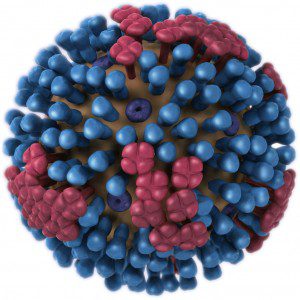

There are two main considerations* when deciding whether to be immunized yearly against influenza: the nature of the vaccine and age of the recipient. Last year€™s seasonal influenza vaccine for the northern hemisphere contained the following strains:
- A/Brisbane/59/2007 (H1N1)
- A/Brisbane/10/2007 (H3N2)
- B/Brisbane/60/2008
Also made available last year was a monovalent vaccine comprising the pandemic strain, A/California/7/2009.
Strains included in the 2010-11 vaccine are:
- A/California/7/2009 (H1N1)
- A/Perth/16/2009 (H3N2)
- B/Brisbane/60/2008
The seasonal H1N1 strains of previous years are no longer circulating and have been eliminated from the vaccine. If you received last year€™s seasonal vaccine and the monovalent vaccine, is it necessary to receive this year€™s vaccine? The answer is yes, because the H3N2 strain is different – last year the vaccine contained a Brisbane strain while this year€™s H3N2 isolate is from Perth. The full WHO report on strain selection is available as a pdf document.
What would be the answer if this year€™s trivalent vaccine were identical to that used last year? The answer would still be to receive the vaccine, because the duration of immunity provided by the inactivated influenza vaccine has always been an issue. In elderly recipients (>65 years of age) immunity barely lasts for a single influenza season. Younger recipients will likely be protected from disease for one influenza season, and perhaps a second season as well, although in the latter case a milder respiratory disease may result. For these reasons the CDC recommends annual immunization against influenza virus for all individuals 6 months of age and older.
The current inactivated influenza vaccines were developed during World War II, and although they have since been refined and purified, there are still deficiencies, including brief duration of protective immunity. Development of new influenza vaccines that not only overcome this problem, but also provide broader protection, is clearly needed.
…
*This post, like everything else on virology blog, does not contain medical advice. It comprises scientific information about the vaccines which can be used, together with your health care provider, to reach a decision about immunization.

Pingback: Tweets that mention Thoughts on this season’s influenza vaccine -- Topsy.com
Pingback: [Crof's H5N1] Racaniello: Thoughts on this season’s influenza vaccine | Influenza Virus Mashup
Does flu mist provide stronger and long-lasting immuity as compared to inactivated vaccine based flu shot? I have heard that vaccine virus in flu mist becomes inactive once it reaches the lungs due to higher temperature there? Is it true?